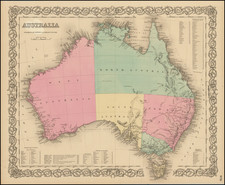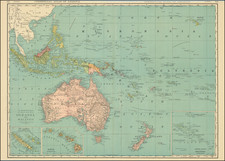First state of George Carter's rare view of the Death of Captain James Cook on the island of Hawaii, based upon a painting by Carter.
Carter's engraving is among the finest images of the death of Cook, very human in its close-up perspective with emotions of Cook and the others sensitively delineated. The print was published separately by Carter a few weeks before the appearance of the authorized atlas for Cook's third voyage, which contained no image of the death of Cook. Along with the Webber-Bartolozzi-Byrne view, it is the most famous of the printed views of Cook's death and quite likely the most accurate and evocative. While John Webber had been the official artist on Cook's Third Voyage, he was not an eye-witness of Cook's death and both artists relied upon verbal accounts and other information provided by eye-witnesses.
As noted in Captain James Cook & His Pacific Legacy (Horden House 2007) Item #50:
Although Carter was not an eye-witness of the scene in Hawaii, his careful reconstruction is based on a thorough investigation of the printed accounts and related visual material from the voyage. The image, recognised as one of the finest depictions of the scene, was first painted in 1781. The engraving was produced by Carter himself, with the print sellers Robert Sayer and George Bennett, and was released a few weeks before the official voyage account, seemingly to capitalise on the fact that the official account did not include an image of Cook's death (although it is the Webber/Bartolozzi image that is commonly seen actually bound into the Atlas volume.
George Carter was an accomplished portrait and history painter and a regular exhibitor at the Royal Academy and the Society of Artists in London in the second half of the eighteenth century. The tragic events of 14 February 1779 at Kaawaloa were perfect material for this painter of historical subjects. His version, like Webber's, moved the scene of the massacre from the flat shoreline of Kaawaloa to the more dramatic setting of Kealakekua with the cliffs in the background.
However, Carter's depiction, is unlike Webber's in several significant ways: firstly, in showing Cook aparently ready to defend himself, his rifle raised like a club, and secondly, by including more closely detailed portraits of several of the Hawaiians in the foreground and, especially, with beautifully realised images of the British sailors in their three boats. Carter's composition, as a result, not only has a heightened drama, but gives a visceral sense of conflict.
. . . the first issue [is] dated January of 1784. Later versions were dated February or April of the same year and other versions appeared in subsequent years, one of them as late as 1794.
Cook's death in Hawaii is one of the iconic images of the 18th Century. Cook was killed in Hawaii on February 14, 1779. He and his men had spent the two months on the Big Island and been well received. They departed in early February 1779 but returned due to storms and the need for ship repairs. The second reception turned hostile, and tensions between the sailors and the natives increased. When Cook went ashore to investigate, a scuffle occurred and Cook was killed.
For Carter's original painting in the National Library of Australia, see: nla.gov.au/nla.pic-an2271058.
The remainder of the credits read as follows: G Carter pinxit [center below image]: S. Smith engraved the landscape [right below image]: J. Hall engraved the Portrait of Capt. Cook, the Figures by J. Thornthwaite. [below title]: London Publish'd as the Act directs by G. Carter of Margaret Street Cavendish Square and Messrs. Sayer & Bennet in Fleet Street Jany. 1st 1784.
The view is very rare on the market, considerably rarer than the Webber-Bartolozzi, especially in the first state. We located only 1 appearance at auction in the past several decades.









![Повстанцы 1863 Года [(Polish) Insurgents of 1863]](https://storage.googleapis.com/raremaps/img/small/52719.jpg)

![Isles de Salomon [Early depiction of New Zealand!]](https://storage.googleapis.com/raremaps/img/small/101683.jpg)
![[ New South Wales Electors in 1871 ] Map Shewing Roads & Postal Stations in New South Wales Prepared for the Use of the Post Office Department](https://storage.googleapis.com/raremaps/img/small/88237.jpg)
![[ Indian Cave and Rock Paintings ] World Primitive Rock Art -- The Conquest of Indian America](https://storage.googleapis.com/raremaps/img/small/93916.jpg)
